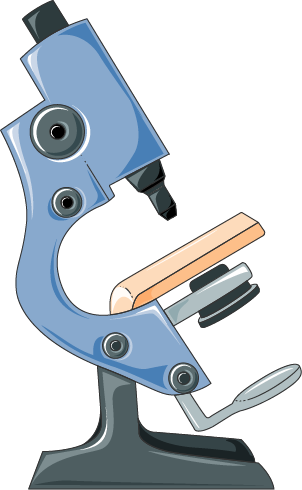Microorganisms
TEAS Science Lesson – Microorganisms
In the previous TEAS science lesson you learned about genetics and DNA. In this lesson, we will review microorganisms, the tiny life forms that have a monumental impact on our health and ecosystems. We’ll review how these beings contribute to the spread of diseases.
Keywords & Concepts
- Microorganisms
- Microbes
- Bacteria
- Virus
- Fungi
- Protozoa
- Parasites
- Pathogenic
- Microbiota
- Mycoses
- Hyphae
- Chitin
- Host
- Helminths
- Infectious
- Non-infectious
- Direct contact transmission
- Indirect contact transmission
- Airborne transmission
- Microscopes
- Light microscope
- Electron microscope
Flashcards & Note Prompts
- Create flashcards that lists out for each type of microorganism their cellular structure, how they reproduce, and any important characteristics.
- Create flashcards that list out for each type of microorganism what kind of diseases they cause and examples for each.
- Create a flashcard that lists examples of infectious and non-infectious diseases.
- Create a flashcard for direct contact, indirect, and airborne transmission, include their definition and types of diseases associated.
- Take notes on light and electron microscopes, specifically what they are used, their pros, and cons.
Introduction to Microorganisms
In the complex fabric of life exists a realm not visible to the naked eye but possessing significant power and influence—the world of microorganisms. These small beings, referred to as microbes, play a role in shaping ecosystems, affecting human health, and potentially impacting historical events through disease.
Microorganisms, commonly called microbes, are tiny living entities that cannot be observed with the naked eye. Microorganisms encompass various life forms, including bacteria, viruses, fungi, protozoa, and parasites. Understanding their cellular makeup, reproduction mechanisms, and distinctive characteristics aids in discerning their roles. These organisms play crucial roles in various ecosystems, including the human body, where they can be both beneficial and harmful. The human body contains roughly the same number of microorganisms as cells. The human body has roughly 30 trillion human cells and 38 trillion bacterial cells.
Microorganisms: Types & Characteristics
Microorganisms encompass a diverse range of organisms, each with unique characteristics and roles in ecosystems. Microbes are classified according to their cell parts, how they look (size and shape), how they move, and how they reproduce. Microbes exhibit an opposing nature in their interactions with other organisms. They can be considered pathogenic or disease-causing or exhibit symbiotic tendencies where they benefit their hosts or environments. They can be broadly classified into several groups: bacteria, viruses, fungi, protozoa, and parasites.
Bacteria
Bacteria are microscopic single-celled organisms that play crucial roles in various ecosystems, including the human body. Bacteria are known for their ability to cause infections and diseases in humans. However, it’s essential to recognize that not all bacteria are harmful; many species are beneficial and even essential for human health. Beneficial bacteria are often referred to as normal flora or microbiota. This is the community of bacteria that naturally inhabit various parts of the human body. For instance, specific bacteria aid digestion, produce essential vitamins like vitamin K, and even contribute to the body’s immune system by outcompeting harmful pathogens.
Pathogenic bacteria possess specific cellular components and structures that contribute to their ability to cause disease. These include cell walls, capsules, flagella, and pili. These structures often facilitate attachment to host tissues, evasion of the immune system, and the production of toxins that damage host cells. In a healthcare setting, it is important to understand how different types of bacteria are transmitted and can ultimately be controlled. For example, bacteria can be spread through direct contact, airborne droplets, or contaminated surfaces. Additionally, bacterial cells can reproduce rapidly through binary fission, allowing them to colonize host tissues and overwhelm the body’s defenses.
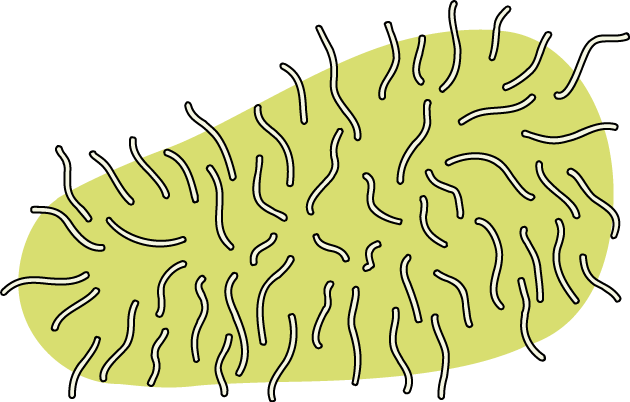
Bacteria [Source]
Pathogenic bacteria are characterized by their ability to produce toxins or enzymes that harm host cells and tissues, their capacity to evade the immune system, and their adaptability through mechanisms like antibiotic resistance.
Examples of diseases caused by pathogenic bacteria include strep throat (caused by Streptococcus pyogenes), urinary tract infections (caused by Escherichia coli), and tuberculosis (caused by Mycobacterium tuberculosis).
Viruses
Viruses exhibit a distinctive structure and composition that distinguish them from other microorganisms. Typically, a virus consists of a nucleic acid core, either DNA or RNA, surrounded by a capsid protein coat. Some viruses also have an outer lipid envelope derived from the host cell membrane. This minimalistic structure allows viruses to infect host cells and exploit their resources for replication efficiently. The process of viral reproduction involves attachment to host cells, entry into the cell, replication of viral genetic material, assembly of new viral particles, and release of progeny viruses to infect other cells. This intricate life cycle enables viruses to spread rapidly within host organisms and across populations.
One of their most well-known roles is their ability to cause infectious diseases in humans, ranging from the common cold to more severe illnesses like influenza, HIV/AIDS, and COVID-19.
By understanding the modes of transmission, healthcare workers can make informed decisions about treating various viral diseases. Viruses can be spread through respiratory droplets, direct contact, contaminated surfaces, vector-borne transmission (e.g., mosquitoes for dengue virus), and vertical transmission (e.g., from mother to child during pregnancy or childbirth).
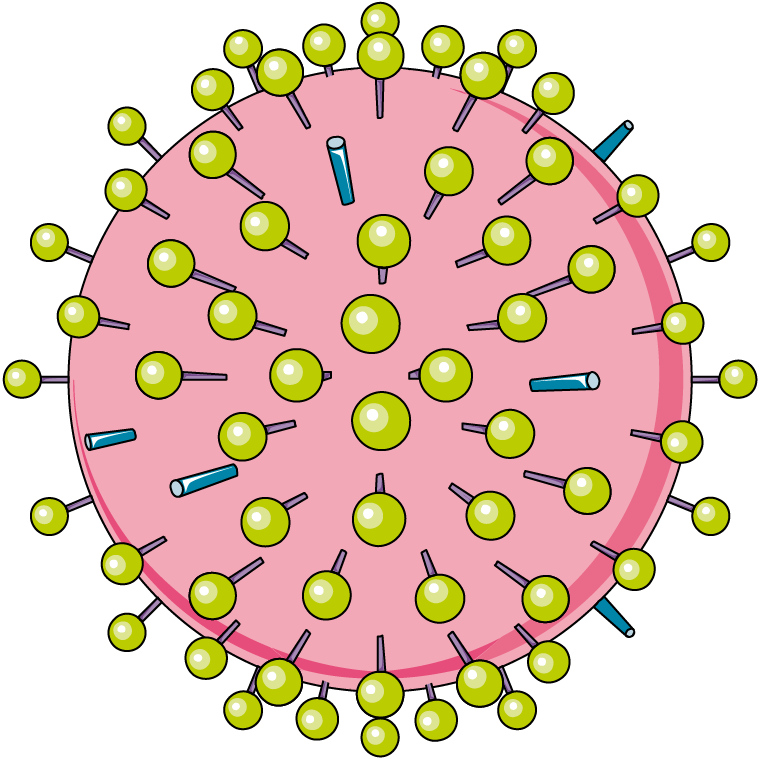
Influenza Virus [Source]
Viruses play a pivotal role in the development of vaccines. Vaccines help prevent viral infections and reduce disease burden. The health care industry utilizes many types of vaccines (live attenuated, inactivated, subunit, and mRNA vaccines). Collectively, they contribute to controlling viral outbreaks and achieving herd immunity.
While viruses are primarily known for their pathogenic potential, it’s important to recognize that not all viruses are harmful. Some viruses can benefit their hosts or even play essential roles in maintaining ecological balance.
Protozoa
Protozoans are unicellular eukaryotic organisms that play various roles in ecosystems, serving as both predators and prey. They are commonly found in diverse environments, including soil, water, and the bodies of plants and animals. Some protozoans, such as amoebas, play vital roles in nutrient cycling by decomposing organic matter. Others, like certain flagellates, contribute to the balance of microbial communities in animals’ gut, aiding digestion. Additionally, certain protozoans are used as model organisms in scientific research to study fundamental biological processes.
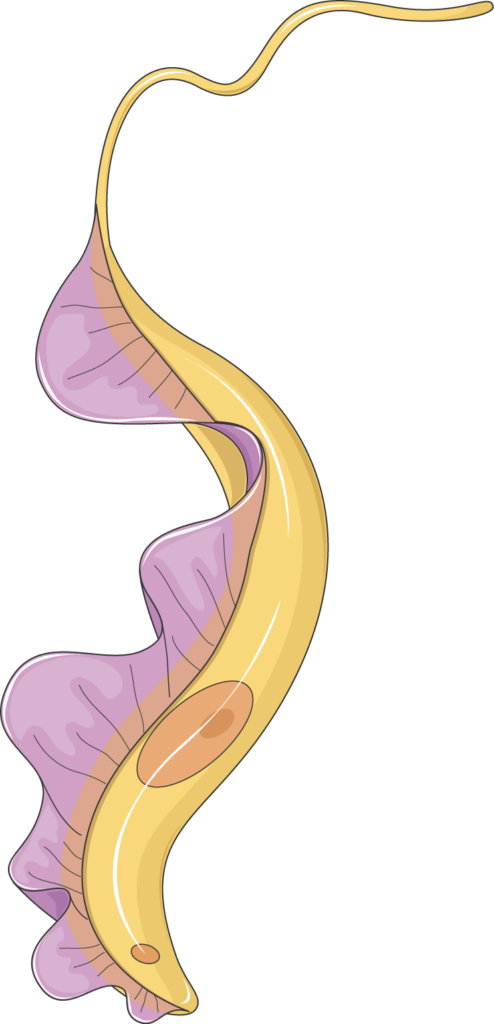
Trypanosoma [Source]
Protozoans have both positive and negative impacts. While they play a role in ecosystems and research, they can also cause diseases in humans and animals. For instance, Plasmodium causes malaria, which is spread by infected mosquitoes.
Other harmful protozoans include Trypanosoma, which leads to African sleeping sickness, and Giardia lamblia, causing giardiasis with symptoms like diarrhea.
Protozoans have diverse structures and components. They typically have a nucleus, cytoplasm, cell membrane, and organelles like mitochondria and Golgi apparatus. Some have special parts for movement, like flagella, cilia, or pseudopodia. These help them move and gather food. Also, many protozoans have complex life cycles involving various stages, including both sexual and asexual reproduction.
Fungi
Fungi are a diverse group of microorganisms that play essential roles in ecosystems, including decomposition, nutrient cycling, and symbiotic relationships with plants. While some fungi are beneficial, such as those used in food production (e.g., yeast in baking and brewing) and medicine (e.g., antibiotics like penicillin), others can cause diseases in humans and other organisms.
Fungal pathogens can infect various tissues and organs, leading to diseases ranging from superficial skin infections to life-threatening systemic infections. Fungi are eukaryotic organisms, meaning their cells contain membrane-bound organelles, including a nucleus, mitochondria, and endoplasmic reticulum. They typically reproduce through the production of spores, which can be dispersed by air, water, or other means.
Fungal diseases, also known as mycoses, can be caused by dermatophytes (e.g., athlete’s foot, ringworm), yeasts (e.g., Candida infections), and molds (e.g., aspergillosis, histoplasmosis).
Effective diagnosis and treatment of fungal infections often require specialized techniques and antifungal medications tailored to the specific organism involved.
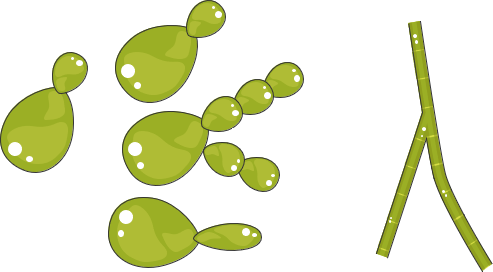
Candida Albicans [Source]
The characteristics of fungi include their ability to grow as single-celled yeasts or multicellular molds with branching filaments called hyphae. Some fungi can switch between these forms depending on environmental conditions. Fungal cell walls contain a complex polysaccharide called chitin, which provides structural support and protection. Fungi obtain nutrients through absorption, secreting enzymes to break down organic matter into smaller molecules that can be absorbed by the hyphae.
However, certain pathogenic fungi can also exploit host tissues for nutrients, leading to tissue damage and disease. Examples of fungal diseases include candidiasis (yeast infection), aspergillosis, cryptococcosis, and pneumocystis pneumonia (PCP).
Parasites
Parasites live in or on a host organism, deriving nutrients at the host’s expense.
Pathogenic potential is a key characteristic of parasites, as they can cause a range of diseases in their hosts. This potential arises from their ability to manipulate host physiology and immune responses, leading to symptoms varying from mild discomfort to severe illness and even death.
Animal parasites invade the bodies in the following ways: direct transmission (e.g. ingestion of contaminated food or water, skin-to-skin contact), vector-borne transmission (e.g. mosquitos, ticks, fleas), and zoonotic transmission (e.g. transmission from animals to humans).
In terms of structure and cellular components, parasites exhibit diverse adaptations suited to their specific hosts and lifestyles. For example, helminths, or parasitic worms, possess specialized structures such as hooks, suckers, or cuticles for attachment to host tissues. They may also have complex life cycles involving multiple hosts, each phase adapted for survival in different environments. Reproduction in parasites can occur through sexual or asexual means, depending on the species. Some parasites produce many eggs or larvae, ensuring their survival and transmission to new hosts.
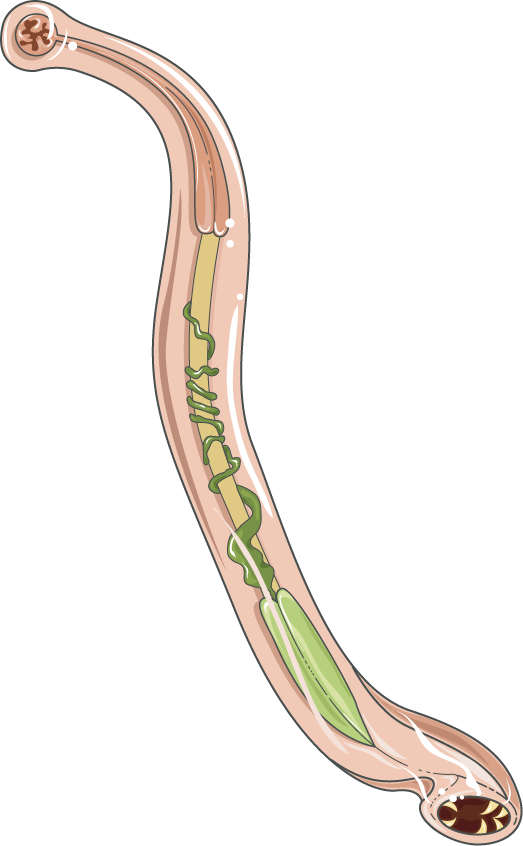
Intestinal hookworm [Source]
Examples of diseases caused by parasites include malaria (Plasmodium spp.), schistosomiasis (Schistosoma spp.), and hookworm infection (Necator americanus, Ancylostoma duodenale), among others, each presenting unique challenges for prevention, diagnosis, and treatment in healthcare settings.
Infectious vs. Non-Infectious Diseases
Diseases are either infectious or non-infectious. Infectious diseases are illnesses caused by pathogenic microorganisms such as bacteria, viruses, parasites, or fungi. These diseases can spread from one person to another through various means, including direct contact with an infected individual, indirect contact through contaminated objects or surfaces, airborne transmission via respiratory droplets, or through vectors like mosquitoes. Non-infectious diseases are conditions not caused by pathogens and cannot be transmitted from person to person. Instead, they typically result from genetic factors, lifestyle choices, environmental exposures, or a combination.
Examples of infectious diseases include influenza, tuberculosis, HIV/AIDS, malaria, and COVID-19. They often require specific interventions such as antibiotics, antiviral medications, or vaccines to prevent or treat them effectively.
Examples of non-infectious diseases include chronic respiratory diseases such as asthma and autoimmune disorders like rheumatoid arthritis. Management and prevention of non-infectious diseases often involve lifestyle modifications, medication, and sometimes surgical interventions.
Microbes and Infectious Diseases Transmission
Diseases can be transmitted through various routes, each posing different risks and requiring distinct preventive measures. Direct contact transmission occurs when an infected person’s bodily fluids, such as blood, saliva, or mucus, come into direct contact with another individual’s mucous membranes or broken skin. Examples include sexually transmitted infections like HIV/AIDS and hepatitis, as well as skin-to-skin contact diseases like scabies.
Indirect contact transmission involves the transfer of pathogens from contaminated surfaces or objects to a person’s hands, which then come into contact with their mucous membranes. Diseases transmitted this way include the common cold, influenza, and gastrointestinal infections like norovirus.
Airborne transmission occurs when infectious agents are released into the air as respiratory droplets from coughing, sneezing, or talking and inhaled by others. Examples include tuberculosis, measles, and COVID-19, highlighting the importance of ventilation and respiratory precautions in preventing the spread of airborne diseases.
Microscopes and Their Uses
Microscopes are essential tools in studying diseases as they allow scientists and medical professionals to observe microscopic organisms and cellular structures that are not visible to the naked eye. A microscope is an instrument that magnifies small objects, enabling detailed examination of their structure and composition. There are various types of microscopes, but two of the most commonly used in disease research are light microscopes and electron microscopes.
Light microscopes use visible light to illuminate specimens, allowing for the observation of live or stained biological samples. They are versatile and relatively easy to use, making them ideal for routine laboratory work and educational purposes. Electron microscopes, on the other hand, use a beam of electrons to create high-resolution images of specimens. They offer much higher magnification and resolution than light microscopes, allowing for the visualization of extremely small structures such as viruses and subcellular organelles.
Light microscopes are great for observing living microorganisms in real-time but struggle with fine details due to limited resolution. On the other hand, electron microscopes offer high resolution and magnification, making them ideal for studying viruses and intricate cellular components, but they’re complex, expensive, and can’t view live specimens. So, light microscopes are good for routine lab work and observing live organisms, while electron microscopes are essential for detailed examination of microorganism structures at the subcellular level.
For Example
Healthcare relies on microscopy for different purposes. It helps diagnose infections, find abnormal cells in cancer checks, and examine tissue samples. Beyond regular microscopy, advanced imaging methods give deeper insights into cell structures and behaviors. Techniques like fluorescence, confocal, and super-resolution imaging help researchers and doctors better understand how diseases work.
Let’s Review
- Microorganisms are tiny living entities, including bacteria, viruses, fungi, protozoa, and parasites, that play crucial roles in ecosystems and human health.
- Microorganisms are classified based on cell parts, appearance, movement, and reproduction mechanisms.
- Bacteria are single-celled organisms that can be beneficial or harmful, causing diseases like strep throat and tuberculosis.
- Viruses are minimalistic structures consisting of DNA or RNA surrounded by a protein coat. They cause infectious diseases such as the common cold and COVID-19.
- Protozoans are unicellular eukaryotic organisms, some of which can cause diseases like malaria and giardiasis.
- Fungi are diverse microorganisms that can be beneficial or pathogenic, causing diseases like athlete’s foot and candidiasis.
- Parasites are organisms that live in or on a host, causing diseases like malaria and schistosomiasis.
- Diseases can be infectious (spread by pathogens) or noninfectious (resulting from genetic factors, lifestyle choices, or environmental exposures).
- Infectious diseases spread through direct contact, indirect contact, or airborne transmission, examples include influenza and tuberculosis.
- Non-infectious diseases result from genetic or environmental factors, including heart disease and diabetes.
- Microscopes, including light and electron microscopes, are essential for studying microscopic organisms and cellular structures.
- Light microscopes use visible light to observe live or stained samples, while electron microscopes provide higher resolution and magnification but require specialized techniques and are more expensive to operate.
- Both types of microscopes have their advantages and are used depending on the specific requirements of the study.
In the next TEAS science lesson we will move to an introduction to chemistry.
You May Subscribe to the online course to gain access to the full lesson content.
If your not ready for a subscription yet, be sure to check out our free practice tests and sample lesson at this link

